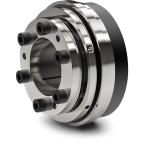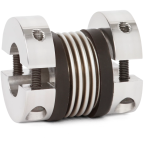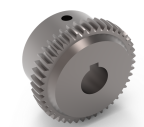Understanding different gear coupling types in mechanical systems
Explore BJ-Gear A/S wide range of gear couplings, including gear tooth couplings, claw and servo couplings, metal couplings, sleeve couplings, metal grid couplings, as well as safety and disengageable couplings. Delve deeper into each coupling type to discover the specific features and benefits tailored to your mechanical system's needs.
Gear tooth couplings
Gear tooth couplings are a type of gear couplings that consist of two parts: a hub and a casing. The hub has gear teeth cut on the outer diameter, while the casing has matching gear teeth cut on the inner diameter. The hub and the casing are connected by the meshing of the gear teeth, which allows them to transmit torque and accommodate some misalignment between the shafts. Gear tooth couplings are made of steel and require lubrication with grease. They are suitable for applications that require high torque and balance, such as cranes, hoists, conveyors, and industrial drives.
Claw and servo couplings
Claw and servo couplings are types of elastic couplings that can transmit high torques with low backlash and compensate for shaft misalignment. They consist of two hub halves connected by an elastomer part, which also provides vibration damping and electrical isolation. Claw and servo couplings are suitable for positioning applications that require precise and reliable power transmission. They are available in different designs, such as split clamping hub, key way connection, or conical clamping ring, depending on the mounting and clamping requirements.
Metal bellow couplings
Metal bellow couplings are shaft couplings that are used to transmit torque or rotary motion between two shafts with high angular accuracy and no backlash. They are suitable for applications that require high dynamic positioning, such as servo drives, machine tools, medical devices, robotics and more. They have several advantages, such as high torsional stiffness, wear- and maintenance-free operation, low moment of inertia, and resistance to high temperatures. Metal bellow couplings are available in different designs, such as clamping hubs, tapered clamping bushes, flange mounting, split hubs, axial pluggable and line shaft.
Sleeve couplings
Sleeve couplings are a type of rigid couplings that consist of a hollow cylinder or sleeve that fits over the ends of two shafts. Sleeve couplings are used to transmit torque between shafts that have no misalignment or end movement. They are simple and easy to install, but they cannot accommodate any flexibility or vibration damping. Sleeve couplings are also known as box couplings or muff couplings and are commonly used in industrial machinery and engines.
Metal grid couplings
Metal grid couplings are a type of flexible couplings that can transmit high torque levels and dampen vibrations and shock loads. They consist of two metal hubs with curved teeth that mesh with a spring-like grid element. The grid element can flex and slide along the hub teeth, allowing for some misalignment and cushioning of impact forces. Metal grid couplings are suitable for applications that require high performance, reliability and easy maintenance.
Safety and disengageable couplings
The safety couplings, also called torque limiter couplings, swiftly interrupt power transmission when torque surpasses a set limit, preventing damage and downtime. Operating on a spring-loaded ball bearing system, they ensure a solid, backlash-free transmission until the preset threshold is exceeded.




